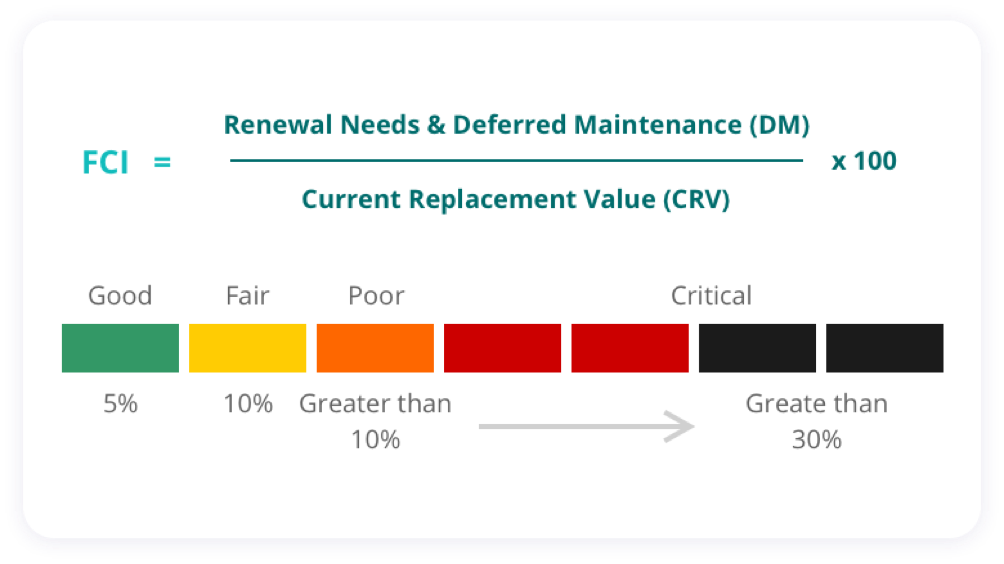
5 Steps to a Value-Driven Building Condition Assessment
by root | administrator | akash.hande@weboniselab.com

Building Condition Assessments (BCAs) are a complete and multi-disciplinary inspection of an organization’s buildings. For facility managers, it is always best practice to have a clear picture of where the building’s assets are in their useful operating life. A Building Condition Assessment not only gives us the ability to review the assets and equipment of a building, but also to confidently and correctly develop appropriate asset management plans and capital budgets for it.
This assessment is often expressed in a Facility Condition Index (FCI), which is an industry-standard metric that provides a benchmark for a building’s condition.
The FCI is calculated as follows:
For a facility manager, knowing the appropriate process is the first step towards a value-driven building assessment.
Here are the 5 steps to conducting a successful Building Condition Assessment:
The first step of a Facility Condition Assessment is to do a preliminary preparation for the inspection. This includes the mobilization of the consulting team of engineers and arranging site access for them. The consulting team should include architects, a mechanical engineer, an electrical engineer, a structural engineer, and a cost estimator. In some inspections, there is also a need for civil engineers, security consultants, heritage consultants, environmental experts, and others, depending on the nature and existing condition of the building.
While selecting an FCA team, make sure it has the most knowledgeable and experienced people required to undertake a detailed and comprehensive assessment. The consulting team should be very clear about the full scope of the project, and the roles and responsibilities should be assigned as per a project-specific briefing. The team should be given the flexibility to bring in creative and innovative ideas to address the unique aspects of the individual project.
While the consulting team inspects a facility, all of the assessment data should be be collected, reviewed, and stored in one place. The consulting team also performs on-site walk-through inspections, taking digital pictures and performing interviews with building staff to gauge the condition of the building components and challenges associated with working in the building. These interviews generally aim to answer some of the questions below:
- What major projects have been performed in the last 5 years?
- What are the ongoing projects, their scopes, and estimated costs?
- What are the in-plan projects and their scopes?
- Are there any recurring or high-maintenance issues regarding any of the systems?
- Are there any active leaks or infiltrations from the building envelope?
- Any other particular concerns?
This interview data also needs to be listed somewhere in order to keep a tab on all the conversations that happened with the interviewees. Some consulting teams also use specific apps to take notes of these findings so that all of the information is collected properly.
The results of the building inspection play a critical role in creating the assessment reports and, consequently, should not be misplaced in any case.
The consulting team then provides you with a detailed report of the assessment. This generally includes:
The Executive Summary. The executive summary contains:
- 5 Year Requirements
- 30 Year Budgets
- 30 Year Budgets Based on Uniformat Level 4
The Introduction. The introduction contains:
- Terms of Reference
- Project Team and Documentation
- Limitations
- Assumptions
- Asset Details
The Assessment Summary. The assessment summary contains:
- Overview of Structural Condition
- Overview of Architectural Condition
- Overview of Heritage Character
- Overview of Seismic
- Overview of Site Condition
- Overview of Vertical and Horizontal Transportation Condition
- Overview of Mechanical Systems Condition
- Overview of Electrical Systems Condition
- Overview of Fire Building Information
- Regulatory Testing Compliance
- Code Compliance Summary
- Overview of Environmental Issues
- Compliance with Accessibility Standards
- Overview of Project Grouping
The 5-year Expenditure Summary. The 5-year expenditure summary contains:
- 5-year Expenditure Chart
- 5-year Expenditure Graph
- 5-year Detailed Expenditure Table
The 30-year Expenditure Summary. The 30-year expenditure summary contains:
- 30-year Expenditure Chart
- 30-year Expenditure Graph
- 30-year Detailed Expenditure Table
The Detailed System/Requirement Analysis. The detailed system/requirement analysis contains:
- System Description
- Service Life
- Actual Age
- Current Replacement Value
- Requirement Statement
- Requirement Justification and Strategy
- Implication of Requirement Deferral
The Renewal Needs and Facility Condition Index (FCI). This renewal needs and FCI section contains:
- Renewal Cost of the Building
- Facility Condition Index (FCI), which identifies the condition of the building
The assessment report needs to be thoroughly analyzed and taken into consideration for future plans regarding the replacement/renewal of the building.
This is generally done by the facility managers and the other facility executives who are actively involved in the FCA process. The report is then reviewed by their peers to examine the data and to check for errors, if any.
In the final stage of the Building Condition Assessment (BCA) process, the assessment report is presented to management and the facility decision-makers. The ultimate purpose of a Building Condition Assessment is to make data-driven decisions about the facility and ensure that the budgeting needs are in line with the projections being made. The management and decision-makers of the facility need to ensure that accurate inference is drawn from the reports, and that any decisions are taken accordingly.
Ultimately, Building Condition Assessments can only be accomplished with the right planning and course of action. To know how to perform a fully-fledged BCA backed by scientific data, check out our step-by-step definitive E-book on Building Condition Assessment.
Other Resources
View moreSubscribe and stay updated with us!
Subscribe to Nadine and stay updated with us. You will receive email notifications whenever we publish new materials on our website.
Nadine uses the information you provide to contact you about our relevant content, products, and services. You may unsubscribe from these communications at any time.





